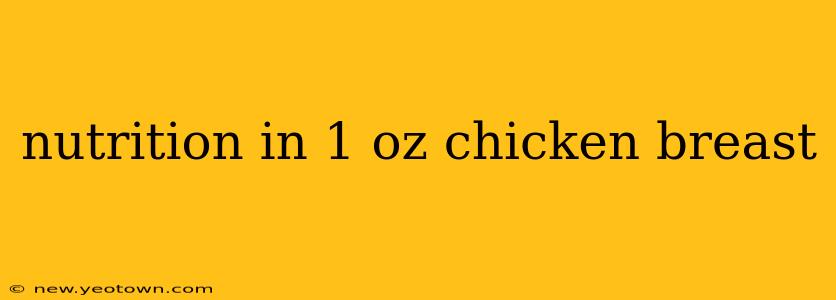The Nutritional Powerhouse: Unpacking the Goodness in 1 Ounce of Chicken Breast
Chicken breast. It's the lean protein champion, the diet staple, the culinary chameleon. But have you ever stopped to truly appreciate the nutritional powerhouse packed into just one ounce? Let's dive into the details, exploring not just the macro-nutrients, but the micronutrients that make this humble piece of poultry so valuable to a healthy diet.
Imagine this: you're preparing a healthy meal, and a single ounce of chicken breast forms the foundation. It’s a seemingly small portion, but it plays a crucial role in your overall nutritional intake. This isn't just about calories; it's about the quality of those calories, and the vital nutrients they deliver.
What are the Macronutrients in 1 Ounce of Chicken Breast?
One ounce of cooked chicken breast typically contains approximately:
-
Protein: Around 7 grams. This is the star of the show! Protein is essential for building and repairing tissues, making enzymes and hormones, and supporting a healthy immune system. Think of it as the body's building block. That 7 grams contributes significantly to your daily protein requirements, particularly important for active individuals or those focused on muscle growth.
-
Fat: Less than 1 gram. Chicken breast is remarkably lean, making it a perfect choice for those watching their fat intake. The small amount of fat present is primarily unsaturated fat, which is considered healthier than saturated fat.
-
Carbohydrates: Negligible. Chicken breast is essentially carbohydrate-free, making it a great option for low-carb diets or those aiming to control their blood sugar levels.
What Vitamins and Minerals are in 1 Ounce of Chicken Breast?
While the macronutrient profile is impressive, it's the micronutrients that often get overlooked. That single ounce provides a small but meaningful contribution of several essential vitamins and minerals:
- Selenium: An antioxidant that protects cells from damage.
- Niacin (Vitamin B3): Crucial for energy metabolism and cell function.
- Vitamin B6: Important for brain development and the production of neurotransmitters.
- Phosphorus: Essential for bone health and energy production.
How Does 1 Ounce of Chicken Breast Fit into a Balanced Diet?
One ounce is a small serving, but it perfectly exemplifies the benefits of lean protein. It can be incorporated into countless dishes: salads, stir-fries, wraps, or simply grilled and enjoyed on its own. Remember, a balanced diet is about variety. While chicken breast provides excellent protein, it’s crucial to incorporate fruits, vegetables, and whole grains to obtain a complete range of nutrients.
Is 1 Ounce of Chicken Breast Enough Protein for a Meal?
This depends entirely on your individual needs and activity level. For some, one ounce might be a small addition to a larger meal, supplementing other protein sources. Others might find it sufficient as part of a lighter meal or snack, especially when paired with other protein-rich foods. The recommended daily protein intake varies greatly depending on factors such as age, sex, activity level, and overall health goals. Consult a registered dietitian or nutritionist for personalized recommendations.
What are the potential downsides of eating too much chicken breast?
While chicken breast is a healthy food, consuming excessive amounts can lead to some potential drawbacks. Over-reliance on a single protein source can lead to nutritional imbalances. Also, consuming too much protein can strain the kidneys in certain individuals. Variety is key.
In conclusion, one ounce of chicken breast represents a significant contribution to a healthy and balanced diet. It’s a convenient and versatile source of lean protein and essential micronutrients. Understanding its nutritional profile empowers you to make informed choices, integrating this powerful little package into your daily meals in a way that best serves your individual needs.

